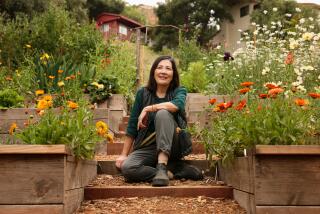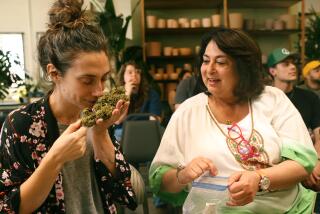Homegrown okra plants: A bit of Louisiana by way of L.A.
Attention, pod people: Have you harvested your okra today?
Okra likes heat and grows fast, making regular harvesting important for gardeners who want to try growing their own. The seed pods should be picked when theyâre immature and only a few inches long. When the pods get larger, they become pithy; the seeds harden, and the plant stops making the flowers that precede the pods.
In the height of production, gardeners should harvest the okra daily. If one stalk stops production, cut it back to the main stem and a new pod-producing branch may appear.
Okra produces pounds of edible seed pods for months. It also sports beautiful pink-yellow-white flowers very much like its hibiscus cousins. And yet this African native doesnât get the respect it deserves. For many, okra (Abelmoschus esculentus, also known as ladyâs fingers) is often synonymous for slimy -- an accurate description of the mucilaginous goo of soluble fiber that is released when the podâs flesh is cut. The mouth feel is a deal breaker to some.
âI like the slimy-ness of it,â says comedian and actor Johnny Pemberton, a gardener at Elysian Valley Community Garden in L.A. âThatâs what makes okra okra.â
Heâs got okra varieties named Clemson Spineless and Red Burgundy in half of a raised bed, and next year heâs going to dedicate a full bed to okra, he says.
The plant grows bushy and can get 6 feet high, creating an effective canopy for lower-growing plants that canât stand the summer sun. His parsley shows no sign of bolting under the okra, he says, meaning the partial shade is helping to preserve and prolong his harvest.
Pembertonâs Louisiana-born mother cooked okra often. He grew up eating a lot of okra, though it didnât occur to him that he could grow his own. He has picked as many as 15 pods a day, he says. âI donât mind the longer ones. Iâll chop them nugget-sized and saute them with some garlic, oil and tomatoes and stew it for a bit.â
Although a tropical plant, okra does fine in temperate zones. It can be fried, baked, steamed and pickled. Itâs often added to thicken soups or sauces. Cooking with smaller pods and some acidic ingredient, such as tomatoes, reduces the goo.
The leaves are edible, as are the mature seeds, which can be roasted and used as a coffee substitute. The unsaturated oil pressed from the seeds is being studied as a possible source for biodiesel fuel.
You can find six-packs at local nurseries, including the Marina del Rey Garden Center. Okra also can be grown from seed; the germination rate is better if the seeds are soaked overnight. Baker Creek is a good source for heritage seeds.
Plants should be spaced at least a foot apart or pruned to improve air circulation, so powdery mildew canât take hold. Staking is advised. Once established, the plants can handle dry soil between waterings.
The most common pests are stinkbugs going after the baby pods. Spray them with a mixture of water and cayenne pepper. Wear gloves when harvesting the okra, because the tiny hairs on the stalk and pods can be irritating.
The Global Garden is our series looking at multicultural L.A. through the lens of its landscapes. It appears here on Tuesdays.
ALSO:
Growing hoyas, colorful succulents
Growing your own cotton plants, carefully
Growing woad, a natural blue dye like indigo
JOIN US:@latimeshome | pinterest.com/latimeshome | facebook.com/latimesgarden






